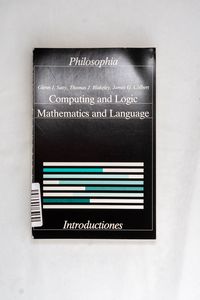
Computing and Logic. Mathematics and Language. Introductiones. - Satty, Glenn J., Thomas J. Blakeley and James G. Colbert
Netto: 4,67 €5€
inkl. MwSt. zzgl. Versand
Bearbeitungszeit: 3 Werktage
Sofort lieferbar (auf Lager)
1x Stück verfügbar
Buchzusammenfassung:
This text is designed to help students overcome their hesitancy in the face of computing by leading them through simple mathematics, including set-theory and two forms of logic (propositional logic and traditional syllogistics), to basic questions of natural-language parsing. After introduction of basic notions on propositions and the nature of logic, the earlier parts center on sets and operations on sets. A discussion on quantifiers forms the bridge to considerations of mathematical logic, whence the discussion moves to Aristotelian syllogistics with its formal proofs and specific form of demonstration. In the last part of the book, the student is encouraged to follow the logical structure of a simple syntactic parser. This is used, then, as a foundation for presentation of some elements of a semantic parser, which approaches the analysis of sentences from the viewpoint of traditional category theory. Throughout the book, the more difficult questions of mathematics and philosophy of logic are illustrated with the use of simple BASIC routines, plus some illustrations in PROLOG, a fifth-generation computing language. This text is recommended for mathematics classes, where the use of the computer will support traditional methods and for philosophy courses, where digitalized logic can help illustrate the evolution of formal methods for logic courses that can benefit from ample exercises in several computer languages and for linguistic sectors that involve parsing and questions of natural language representation in formal languages. Suitable as textbook for courses in Logic (undergraduate level), Introduction to Computer Programming, Symbolic Logic. Of interest to: Philosophers, computer scientists, linguists, logicians, mathematicians.
FAQ zum Buch
Von den 64 möglichen Modi sind nur neunzehn gültig. Dies wird im Text explizit erwähnt, als es heißt, dass nur neunzehn von den 64 konzipierbaren Modi gültig sind. Dieses FAQ wurde mit KI erstellt, basierend auf der Quelle: S. 105, ISBN 9783884050712
Der Enthymem kann nicht gültig gemacht werden, weil die Ergänzung des fehlenden Prämissen entweder einen unverteilten Mittelbegriff oder einen illoyalen kleiner Begriff verursacht. Beide Versuche, die Prämissen zu vervollständigen, führen zu logischen Fehlern, die die Gültigkeit des Syllogismus verhindern. Dieses FAQ wurde mit KI erstellt, basierend auf der Quelle: S. 116, ISBN 9783884050712
Das Beispiel verwendet die Form des Modus ponendo ponens. Es ist gültig, weil die Prämisse „Wenn p, dann q“ und die weitere Prämisse „p“ zusammen die Konklusion „q“ logisch erzwingen. Dieses FAQ wurde mit KI erstellt, basierend auf der Quelle: S. 120, ISBN 9783884050712
Der Text besagt, dass die Deduktion von der Allgemeinheit (oder universellen) zur Besonderheit (oder individuellen) geht, während die Induktion von der Besonderheit zur Allgemeinheit aufsteigt. Dieser Unterschied unterstreicht die entgegengesetzten Richtungen des Denkens bei diesen beiden Methoden. Dieses FAQ wurde mit KI erstellt, basierend auf der Quelle: S. 140, ISBN 9783884050712





